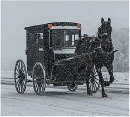Is there anything for Evangelicals to learn?
Visitors to places like St. Jacobs, Ont., may be surprised to see the parking lots include covered stalls and hitching posts for horses. Locals know these amenities are there for Old Order Mennonites, or "horse and buggy" people. But who are they?
The Old Order are a branch of the Mennonite tradition that came to North America in the 18th century. By the late 19th century increasing urbanization and industrialization were bringing Mennonites into increasing contact with their non-Mennonite neighbours. Some Mennonites wanted to borrow new ideas from other Christian traditions such as the Methodists, including the use of Sunday schools, revival meetings, musical instruments and an emphasis on a conversion experience followed by assurance of salvation and public testimony.
For some more traditionally minded Mennonites, these changes threatened Anabaptist values. As farmer-historian Donald Martin explains, the key principle was Gelassenheit, a German word meaning roughly yieldedness. Gelassenheit means a willingness to humbly follow Christ in His sufferings and surrender to His will. It entails putting aside your own ideas and prerogatives, rejecting pride and frivolous pleasure seeking, and submitting to the discipline of the community.
In the eyes of traditionalist Mennonites, the new lifestyles and ideas smacked of pride and worldliness, and undermined the order and unity of their brotherhood. They ran counter to Gelassenheit.

The Old Order are willing to look strange in the eyes of the world as the price of following Jesus.
In Ontario these tensions led to a split between the Old Order and other Mennonites in the 1880s. In the decades that followed, the Old Order stuck with the simple, dark clothing of the Victorian era, including bonnets and caps for women, and plain suits without lapels for married men. They accepted motorized farm equipment for work, but mostly rejected the automobile as an unnecessary indulgence – hence the horse-drawn buggies.
Most other Mennonites gradually adopted modern dress and technology along with the larger society, especially in the second half of the 20th century. As a result the Old Order with their distinct clothing and buggies stood out more and more visibly. (It’s worth noting there are also other Mennonite, Amish and Hutterite groups with visibly traditional practices which are not always easy for outsiders to tell apart from the Old Order.)
At first glance it may seem today’s Evangelicals have little to learn from the Old Order. Evangelicals accept as good developments the things that the Old Order wanted to avoid, like Sunday schools, musical instruments, public testimonies of personal conversion and modern conveniences.
4,000
APPROXIMATE NUMBER OF OLD ORDER MENNONITES IN CANADA. THERE HAS BEEN GROWTH IN THE LAST FEW DECADES WITH NEW CONGREGATIONS FORMING IN LINDSAY, MASSEY AND MATHESON, ONT. WWW.CANADIANMENNONITE.ORG
Evangelicals are also rightfully wary of legalism. The Bible warns about the dangers of measuring your spiritual status by external appearances rather than the heart (Matthew 23:25–26), elevating minor points above major commands (Matthew 23:23–24) and imposing man-made rules beyond the requirements of Scripture (Mark 7:1–8). Old Order clothing rules, for example, seem to stray into this category – though an Old Order perspective might reply that contemporary fashions carry dangers too, like encouraging pride, lust, and envy.
While recognizing such disagreements, there is still much Evangelicals can learn from Old Order practices.
Community. The custom of community barn raising is just the most well-known example of the tightknit, mutually supportive nature of Old Order community at its best. They even refuse insurance and government programs like pensions because they believe the church should look after the bereaved or ill among them. What would the equivalent look like in our churches for someone going through illness or who has lost their job?
Simplicity. By avoiding most modern technology, entertainment and luxuries, Old Order communities are spared many of the distractions and pressures that keep the rest of us bombarded with questionable content, worried and glued to our screens. And more of their earnings are left over to help them stay out of debt, support struggling families and give to the poor.
Separateness. The Old Order are willing to look strange in the eyes of the world as the price of following Jesus. Evangelicals for the past 30 years have focused almost exclusively on the opposite approach – trying to look reassuringly normal to our non-Christian friends and neighbours to remove barriers to the gospel. While this approach has advantages, it also comes with dangers, such as gradual conformity to the world’s priorities and standards. Perhaps learning from the Old Order can help us find balance here.